The Regional Hydro-Ecological Simulation System for 30 Years: A Systematic Review
Abstract
1. Introduction
2. The Basic Structure and Development History of RHESSys
3. Research Trends and Characteristics
4. Main Application Progress of RHESSys
4.1. Climate Change
4.2. Disturbance
4.3. Urbanization
4.4. Water Quality
4.5. Land Management
4.6. Biogeochemical Cycle
5. Calibration, Validation, and Uncertainty Analysis of RHESSys
5.1. Calibration
5.2. Verification and Uncertainty Analysis
6. Future Perspectives of RHESSys
6.1. Key Challenges
6.2. Future Directions
7. Conclusions
Supplementary Materials
Author Contributions
Funding
Acknowledgments
Conflicts of Interest
References
- Band, L.E.; Patterson, P.; Nemani, R.; Running, S.W. Forest Ecosystem Processes at the Watershed Scale-Incorporating Hillslope Hydrology. Agric. For. Meteorol. 1993, 63, 93–126. [Google Scholar] [CrossRef]
- Tague, C.L.; Band, L.E. RHESSys: Regional Hydro-Ecologic Simulation System-An Object-Oriented Approach to Spatially Distributed Modeling of Carbon, Water, and Nutrient Cycling. Earth Interact. 2004, 8, 1–42. [Google Scholar] [CrossRef]
- Bart, R.R.; Kennedy, M.C.; Tague, C.L.; McKenzie, D. Integrating fire effects on vegetation carbon cycling within an ecohydrologic model. Ecol. Model. 2020, 416, 16. [Google Scholar] [CrossRef]
- Kennedy, M.C.; McKenzie, D.; Tague, C.; Dugger, A.L. Balancing uncertainty and complexity to incorporate fire spread in an eco-hydrological model. Int. J. Wildland Fire 2017, 26, 706–718. [Google Scholar] [CrossRef]
- Kim, J.H.; Hwang, T.; Yang, Y.; Schaaf, C.L.; Boose, E.; Munger, J.W. Warming-Induced Earlier Greenup Leads to Reduced Stream Discharge in a Temperate Mixed Forest Catchment. J. Geophys. Res. Biogeosci. 2018, 123, 1960–1975. [Google Scholar] [CrossRef]
- Martin, K.L.; Hwang, T.; Vose, J.M.; Coulston, J.W.; Wear, D.N.; Miles, B.; Band, L.E. Watershed impacts of climate and land use changes depend on magnitude and land use context. Ecohydrology 2017, 10, e1870. [Google Scholar] [CrossRef]
- Mohammed, I.N.; Tarboton, D.G. Simulated watershed responses to land cover changes using the Regional Hydro-Ecological Simulation System. Hydrol. Process. 2014, 28, 4511–4528. [Google Scholar] [CrossRef]
- Zabalza-Martínez, J.; Vicente-Serrano, S.; López-Moreno, J.; Borràs Calvo, G.; Savé, R.; Pascual, D.; Pla, E.; Morán-Tejeda, E.; Domínguez-Castro, F.; Tague, C.L. The Influence of Climate and Land-Cover Scenarios on Dam Management Strategies in a High Water Pressure Catchment in Northeast Spain. Water 2018, 10, 1668. [Google Scholar] [CrossRef]
- Peng, H.; Jia, Y.W.; Tague, C.; Slaughter, P. An Eco-Hydrological Model-Based Assessment of the Impacts of Soil and Water Conservation Management in the Jinghe River Basin, China. Water 2015, 7, 6301–6320. [Google Scholar] [CrossRef]
- Running, S.W.; Nemani, R.R.; Hungerford, R.D. Extrapolation of Synoptic Meteorological Data in Mountainous Terrain and Its Use for Simulating Forest Evapotranspiration and Photosynthesis. Can. J. For. Res. 1987, 17, 472–483. [Google Scholar] [CrossRef]
- Running, S.W.; Coughlan, J.C. A general model of forest ecosystem processes for regional applications I. Hydrologic balance, canopy gas exchange and primary production processes. Ecol. Model. 1988, 42, 125–154. [Google Scholar] [CrossRef]
- Beven, K.J.; Kirkby, M.J. A physically based, variable contributing area model of basin hydrology/Un modèle à base physique de zone d’appel variable de l’hydrologie du bassin versant. Hydrol. Sci. Bull. 1979, 24, 43–69. [Google Scholar] [CrossRef]
- Parton, W.J.; Mosier, A.R.; Ojima, D.S.; Valentine, D.W.; Schimel, D.S.; Weier, K.; Kulmala, A.E. Generalized model for N2and N2O production from nitrification and denitrification. Glob. Biogeochem. Cycles 1996, 10, 401–412. [Google Scholar] [CrossRef]
- Band, L.E.; Tague, C.L.; Groffman, P.; Belt, K. Forest ecosystem processes at the watershed scale: Hydrological and ecological controls of nitrogen export. Hydrol. Process. 2001, 15, 2013–2028. [Google Scholar] [CrossRef]
- About RHESSys. Available online: http://fiesta.bren.ucsb.edu/~rhessys/about/about.html#intro (accessed on 14 November 2019).
- Colorado State Geography Presentation. Available online: http://fiesta.bren.ucsb.edu/~rhessys/setup/downloads/files/colorado_geog.pdf (accessed on 14 November 2019).
- Gorelick, D.E.; Lin, L.; Zeff, H.B.; Kim, Y.; Vose, J.M.; Coulston, J.W.; Wear, D.N.; Band, L.E.; Reed, P.M.; Characklis, G.W. Accounting for Adaptive Water Supply Management When Quantifying Climate and Land Cover Change Vulnerability. Water Resour. Res. 2020, 56, 27. [Google Scholar] [CrossRef]
- Morán-Tejeda, E.; Zabalza, J.; Rahman, K.; Gago-Silva, A.; López-Moreno, J.I.; Vicente-Serrano, S.; Lehmann, A.; Tague, C.L.; Beniston, M. Hydrological impacts of climate and land-use changes in a mountain watershed: Uncertainty estimation based on model comparison. Ecohydrology 2015, 8, 1396–1416. [Google Scholar] [CrossRef]
- Watson, F.G.R.; Vertessy, R.A.; Grayson, R.B. Large-scale modelling of forest hydrological processes and their long-term effect on water yield. Hydrol. Process. 1999, 13, 689–700. [Google Scholar] [CrossRef]
- Arnold, J.G.; Srinivasan, R.; Muttiah, R.S.; Williams, J.R. Large Area Hydrologic Modeling and Assessment Part I: Model Development. J. Am. Water Resour. Assoc. 1998, 34, 73–89. [Google Scholar] [CrossRef]
- Govind, A.; Chen, J.M.; Margolis, H.; Ju, W.M.; Sonnentag, O.; Giasson, M.A. A spatially explicit hydro-ecological modeling framework (BEPS-TerrainLab V2.0): Model description and test in a boreal ecosystem in Eastern North America. J. Hydrol. 2009, 367, 200–216. [Google Scholar] [CrossRef]
- Ivanov, V.Y.; Bras, R.L.; Vivoni, E.R. Vegetation-hydrology dynamics in complex terrain of semiarid areas: 1. A mechanistic approach to modeling dynamic feedbacks. Water Resour. Res. 2008, 44, 34. [Google Scholar] [CrossRef]
- Khan, K.S.; Kunz, R.; Kleijnen, J.; Antes, G. Five steps to conducting a systematic review. J. R. Soc. Med. 2003, 96, 118–121. [Google Scholar] [CrossRef] [PubMed]
- Where Is RHESSys Being Used? Available online: https://tagueteamlab.org/portfolio/where-is-rhessys-being-used (accessed on 15 June 2019).
- Tsamir, M.; Gottlieb, S.; Preisler, Y.; Rotenberg, E.; Tatarinov, F.; Yakir, D.; Tague, C.; Klein, T. Stand density effects on carbon and water fluxes in a semi-arid forest, from leaf to stand-scale. For. Ecol. Manag. 2019, 453, 117573. [Google Scholar] [CrossRef]
- Baron, J.S.; Hartman, M.D.; Kittel, T.G.F.; Band, L.E.; Ojima, D.S.; Lammers, R.B. Effects of land cover, water redistribution, and temperature on ecosystem processes in the South Platte Basin. Ecol. Appl. 1998, 8, 1037–1051. [Google Scholar] [CrossRef]
- Stocker, T.F.; Qin, D.; Plattner, G.K.; Tignor, M.; Allen, S.K.; Boschung, J.; Nauels, A.; Xia, Y.; Bex, V.; Midgley, P.M. IPCC, 2013: Climate Change 2013: The Physical Science Basis; Cambridge University Press: Cambridge, UK; New York, NY, USA, 2013; p. 1535. [Google Scholar]
- Troch, P.A.; Martinez, G.F.; Pauwels, V.R.N.; Durcik, M.; Sivapalan, M.; Harman, C.; Brooks, P.D.; Gupta, H.; Huxman, T. Climate and vegetation water use efficiency at catchment scales. Hydrol. Process. 2009, 23, 2409–2414. [Google Scholar] [CrossRef]
- Wang, L.; D’Odorico, P.; Evans, J.P.; Eldridge, D.J.; McCabe, M.F.; Caylor, K.K.; King, E.G. Dryland ecohydrology and climate change: Critical issues and technical advances. Hydrol. Earth Syst. Sci. 2012, 16, 2585–2603. [Google Scholar] [CrossRef]
- Wang, L.X.; Wei, X.H.; Bishop, K.; Reeves, A.D.; Ursino, N.; Winkler, R. Vegetation changes and water cycle in a changing environment. Hydrol. Earth Syst. Sci. 2018, 22, 1731–1734. [Google Scholar] [CrossRef]
- Son, K.; Tague, C. Hydrologic responses to climate warming for a snow-dominated watershed and a transient snow watershed in the California Sierra. Ecohydrology 2019, 12, e2053. [Google Scholar] [CrossRef]
- Lopez-Moreno, J.I.; Zabalza, J.; Vicente-Serrano, S.M.; Revuelto, J.; Gilaberte, M.; Azorin-Molina, C.; Moran-Tejeda, E.; Garcia-Ruiz, J.M.; Tague, C. Impact of climate and land use change on water availability and reservoir management: Scenarios in the Upper Aragon River, Spanish Pyrenees. Sci. Total Environ. 2014, 493, 1222–1231. [Google Scholar] [CrossRef]
- Bart, R.R.; Tague, C.L.; Moritz, M.A. Effect of Tree-to-Shrub Type Conversion in Lower Montane Forests of the Sierra Nevada (USA) on Streamflow. PLoS ONE 2016, 11, e0161805. [Google Scholar] [CrossRef]
- Hanan, E.J.; Tague, C.; Choate, J.; Liu, M.; Kolden, C.; Adam, J. Accounting for disturbance history in models: Using remote sensing to constrain carbon and nitrogen pool spin-up. Ecol. Appl. 2018, 28, 1197–1214. [Google Scholar] [CrossRef]
- Goodale, C.L.; Aber, J.D.; McDowell, W.H. The long-term effects of disturbance on organic and inorganic nitrogen export in the White Mountains, New Hampshire. Ecosystems 2000, 3, 433–450. [Google Scholar] [CrossRef]
- Li, X.Y.; Zhang, S.Y.; Peng, H.Y.; Hu, X.; Ma, Y.J. Soil water and temperature dynamics in shrub-encroached grasslands and climatic implications: Results from Inner Mongolia steppe ecosystem of north China. Agric. For. Meteorol. 2013, 171, 20–30. [Google Scholar] [CrossRef]
- Saksa, P.C.; Conklin, M.H.; Battles, J.J.; Tague, C.L.; Bales, R.C. Forest thinning impacts on the water balance of Sierra Nevada mixed-conifer headwater basins. Water Resour. Res. 2017, 53, 5364–5381. [Google Scholar] [CrossRef]
- Hwang, T.; Kangw, S.; Kim, J.; Kim, Y.; Lee, D.; Band, L. Evaluating drought effect on MODIS Gross Primary Production (GPP) with an eco-hydrological model in the mountainous forest, East Asia. Glob. Chang. Biol. 2008, 14, 1037–1056. [Google Scholar] [CrossRef]
- Pataki, D.E.; Boone, C.G.; Hogue, T.S.; Jenerette, G.D.; McFadden, J.P.; Pincetl, S. Ecohydrology Bearings-Invited Commentary Socio-ecohydrology and the urban water challenge. Ecohydrology 2011, 4, 341–347. [Google Scholar] [CrossRef]
- Miles, B.; Band, L.E. Green infrastructure stormwater management at the watershed scale: Urban variable source area and watershed capacitance. Hydrol. Process. 2015, 29, 2268–2274. [Google Scholar] [CrossRef]
- Tague, C.; Pohl-Costello, M. The Potential Utility of Physically Based Hydrologic Modeling in Ungauged Urban Streams. Ann. Assoc. Am. Geogr. 2008, 98, 818–833. [Google Scholar] [CrossRef]
- Tague, C.; Band, L. Simulating the impact of road construction and forest harvesting on hydrologic response. Earth Surf. Process. Landf. 2001, 26, 135–151. [Google Scholar] [CrossRef]
- Shields, C.; Tague, C. Ecohydrology in semiarid urban ecosystems: Modeling the relationship between connected impervious area and ecosystem productivity. Water Resour. Res. 2015, 51, 302–319. [Google Scholar] [CrossRef]
- Bell, C.D.; Tague, C.L.; McMillan, S.K. Modeling Runoff and Nitrogen Loads From a Watershed at Different Levels of Impervious Surface Coverage and Connectivity to Storm Water Control Measures. Water Resour. Res. 2019, 55, 2690–2707. [Google Scholar] [CrossRef]
- Rai, A.; Minsker, B.; Sullivan, W.; Band, L. A novel computational green infrastructure design framework for hydrologic and human benefits. Environ. Model. Softw. 2019, 118, 252–261. [Google Scholar] [CrossRef]
- Wang, Y.P.; Jiang, R.G.; Xie, J.C.; Zhao, Y.; Yan, D.F.; Yang, S.Y. Soil and Water Assessment Tool (SWAT) Model: A Systemic Review. J. Coast. Res. 2019, 93, 22–30. [Google Scholar] [CrossRef]
- Tague, C.; McMichael, C.; Hope, A.; Choate, J.; Clark, R. Application of the RHESSys model to a California semiarid shrubland watershed. J. Am. Water Resour. Assoc. 2004, 40, 575–589. [Google Scholar] [CrossRef]
- Son, K.; Lin, L.; Band, L.; Owens, E.M. Modelling the interaction of climate, forest ecosystem, and hydrology to estimate catchment dissolved organic carbon export. Hydrol. Process. 2019, 33, 1448–1464. [Google Scholar] [CrossRef]
- Hart, B.T. The Australian Murray-Darling Basin Plan: Factors leading to its successful development. Ecohydrol. Hydrobiol. 2016, 16, 229–241. [Google Scholar] [CrossRef]
- Lacan, I.; Resh, V.H. A case study in integrated management: Sacramento-San Joaquin Rivers and Delta of California, USA. Ecohydrol. Hydrobiol. 2016, 16, 215–228. [Google Scholar] [CrossRef]
- Cheng, G.D.; Li, X. Integrated research methods in watershed science. Sci. China-Earth Sci. 2015, 58, 1159–1168. [Google Scholar] [CrossRef]
- Zierl, B.; Bugmann, H. Global change impacts on hydrological processes in Alpine catchments. Water Resour. Res. 2005, 41. [Google Scholar] [CrossRef]
- Morales, P.; Sykes, M.T.; Prentice, I.C.; Smith, P.; Smith, B.; Bugmann, H.; Zierl, B.; Friedlingstein, P.; Viovy, N.; Sabaté, S.; et al. Comparing and evaluating process-based ecosystem model predictions of carbon and water fluxes in major European forest biomes. Glob. Chang. Biol. 2005, 11, 2211–2233. [Google Scholar] [CrossRef]
- Zierl, B.; Bugmann, H. Sensitivity of carbon cycling in the European Alps to changes of climate and land cover. Clim. Chang. 2007, 85, 195–212. [Google Scholar] [CrossRef][Green Version]
- Son, K.; Tague, C.; Hunsaker, C. Effects of Model Spatial Resolution on Ecohydrologic Predictions and Their Sensitivity to Inter-Annual Climate Variability. Water 2016, 8, 321. [Google Scholar] [CrossRef]
- Bell, C.D.; Tague, C.L.; McMillan, S.K. A model of hydrology and water quality for stormwater control measures. Environ. Model. Softw. 2017, 95, 29–47. [Google Scholar] [CrossRef]
- Beven, K. Prophecy, Reality and Uncertainty in Distributed Hydrological Modeling. Adv. Water Resour. 1993, 16, 41–51. [Google Scholar] [CrossRef]
- Beven, K.; Freer, J. Equifinality, data assimilation, and uncertainty estimation in mechanistic modelling of complex environmental systems using the GLUE methodology. J. Hydrol. 2001, 249, 11–29. [Google Scholar] [CrossRef]
- Shin, H.; Park, M.; Lee, J.; Lim, H.; Kim, S.J. Evaluation of the effects of climate change on forest watershed hydroecology using the RHESSys model: Seolmacheon catchment. Paddy Water Environ. 2019, 17, 581–595. [Google Scholar] [CrossRef]
- Hwang, T.; Band, L.E.; Hales, T.C.; Miniat, C.F.; Vose, J.M.; Bolstad, P.V.; Miles, B.; Price, K. Simulating vegetation controls on hurricane-induced shallow landslides with a distributed ecohydrological model. J. Geophys. Res. Biogeosci. 2015, 120, 361–378. [Google Scholar] [CrossRef]
- Tague, C.; Peng, H. The sensitivity of forest water use to the timing of precipitation and snowmelt recharge in the California Sierra: Implications for a warming climate. J. Geophys. Res. Biogeosci. 2013, 118, 875–887. [Google Scholar] [CrossRef]
- Tague, C.; Seaby, L.; Hope, A. Modeling the eco-hydrologic response of a Mediterranean type ecosystem to the combined impacts of projected climate change and altered fire frequencies. Clim. Chang. 2008, 93, 137–155. [Google Scholar] [CrossRef]
- Sanford, S.E.; Creed, I.F.; Tague, C.L.; Beall, F.D.; Buttle, J.M. Scale-dependence of natural variability of flow regimes in a forested landscape. Water Resour. Res. 2007, 43. [Google Scholar] [CrossRef]
- Peng, H.; Tague, C.; Jia, Y.W. Evaluating the eco-hydrologic impacts of reforestation in the Loess Plateau, China, using an eco-hydrologic model. Ecohydrology 2016, 9, 498–513. [Google Scholar] [CrossRef]
- Boisramé, G.F.S.; Thompson, S.E.; Tague, C.; Stephens, S.L. Restoring a Natural Fire Regime Alters the Water Balance of a Sierra Nevada Catchment. Water Resour. Res. 2019, 55, 5751–5769. [Google Scholar] [CrossRef]
- Zierl, B.; Bugmann, H.; Tague, C.L. Water and carbon fluxes of European ecosystems: An evaluation of the ecohydrological model RHESSys. Hydrol. Process. 2007, 21, 3328–3339. [Google Scholar] [CrossRef]
- Garcia, E.S.; Tague, C.L. Subsurface storage capacity influences climate-evapotranspiration interactions in three western United States catchments. Hydrol. Earth Syst. Sci. 2015, 19, 4845–4858. [Google Scholar] [CrossRef]
- Kim, J.; Hwang, T.; Schaaf, C.L.; Orwig, D.A.; Boose, E.; Munger, J.W. Increased water yield due to the hemlock woolly adelgid infestation in New England. Geophys. Res. Lett. 2017, 44, 2327–2335. [Google Scholar] [CrossRef]
- White, M.; Thornton, P.; Running, S.; Nemani, R.R. Parameterization and sensitivity analysis of the BIOME–BGC terrestrial ecosystem model: Net primary production controls. Earth Interact. 2000, 4, 1–85. [Google Scholar] [CrossRef]
- Christensen, L.; Tague, C.L.; Baron, J.S. Spatial patterns of simulated transpiration response to climate variability in a snow dominated mountain ecosystem. Hydrol. Process. 2008, 22, 3576–3588. [Google Scholar] [CrossRef]
- Shields, C.A.; Tague, C.L. Assessing the Role of Parameter and Input Uncertainty in Ecohydrologic Modeling: Implications for a Semi-arid and Urbanizing Coastal California Catchment. Ecosystems 2012, 15, 775–791. [Google Scholar] [CrossRef]
- Baron, J.S.; Hartman, M.D.; Band, L.E.; Lammers, R.B. Sensitivity of a high-elevation Rocky Mountain watershed to altered climate and CO2. Water Resour. Res. 2000, 36, 89–99. [Google Scholar] [CrossRef]
- Garcia, E.S.; Tague, C.L.; Choate, J.S. Influence of spatial temperature estimation method in ecohydrologic modeling in the Western Oregon Cascades. Water Resour. Res. 2013, 49, 1611–1624. [Google Scholar] [CrossRef]
- Tague, C.; Grant, G.; Farrell, M.; Choate, J.; Jefferson, A. Deep groundwater mediates streamflow response to climate warming in the Oregon Cascades. Clim. Chang. 2007, 86, 189–210. [Google Scholar] [CrossRef]
- Vicente-Serrano, S.M.; Camarero, J.J.; Zabalza, J.; Sanguesa-Barreda, G.; Lopez-Moreno, J.I.; Tague, C.L. Evapotranspiration deficit controls net primary production and growth of silver fir: Implications for Circum-Mediterranean forests under forecasted warmer and drier conditions. Agric. For. Meteorol. 2015, 206, 45–54. [Google Scholar] [CrossRef]
- Hwang, T.; Martin, K.L.; Vose, J.M.; Wear, D.; Miles, B.; Kim, Y.; Band, L.E. Nonstationary Hydrologic Behavior in Forested Watersheds Is Mediated by Climate-Induced Changes in Growing Season Length and Subsequent Vegetation Growth. Water Resour. Res. 2018, 54, 5359–5375. [Google Scholar] [CrossRef]
- Reyes, J.J.; Tague, C.L.; Evans, R.D.; Adam, J.C. Assessing the Impact of Parameter Uncertainty on Modeling Grass Biomass Using a Hybrid Carbon Allocation Strategy. J. Adv. Modeling Earth Syst. 2017, 9, 2968–2992. [Google Scholar] [CrossRef]
- Leonard, L.; Miles, B.; Heidari, B.; Lin, L.; Castronova, A.M.; Minsker, B.; Lee, J.; Scaife, C.; Band, L.E. Development of a participatory Green Infrastructure design, visualization and evaluation system in a cloud supported jupyter notebook computing environment. Environ. Model. Softw. 2019, 111, 121–133. [Google Scholar] [CrossRef]
- Silberstein, R.P. Hydrological models are so good, do we still need data? Environ. Model. Softw. 2006, 21, 1340–1352. [Google Scholar] [CrossRef]
- Kirkpatrick, S.; Gelatt, C.D., Jr.; Vecchi, M.P. Optimization by simulated annealing. Science 1983, 220, 671–680. [Google Scholar] [CrossRef]
- Holland, J.H. Adapation in Natural and Artificial Systems: An introductory Analysis with Applications to Biology, Control, and Artificial Intelligence; University of Michigan Press: Ann Arbor, MI, USA, 1975. [Google Scholar]
- Duan, Q.Y.; Sorooshian, S.; Gupta, V. Effective and Efficient Global Optimization for Conceptual Rainfall-Runoff Models. Water Resour. Res. 1992, 28, 1015–1031. [Google Scholar] [CrossRef]
- Fatichi, S.; Pappas, C.; Ivanov, V.Y. Modeling plant-water interactions: An ecohydrological overview from the cell to the global scale. Wiley Interdiscip. Rev. Water 2016, 3, 327–368. [Google Scholar] [CrossRef]
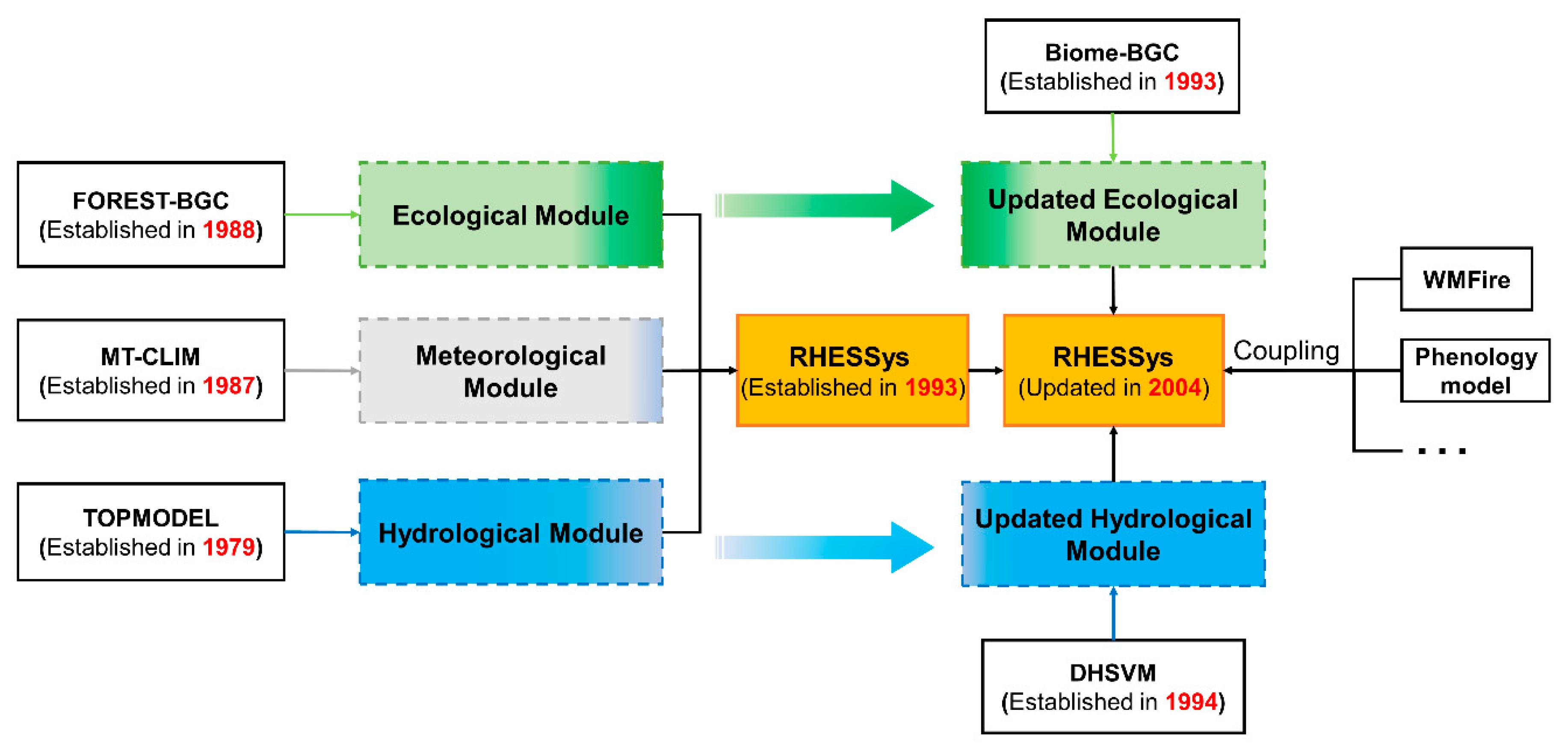
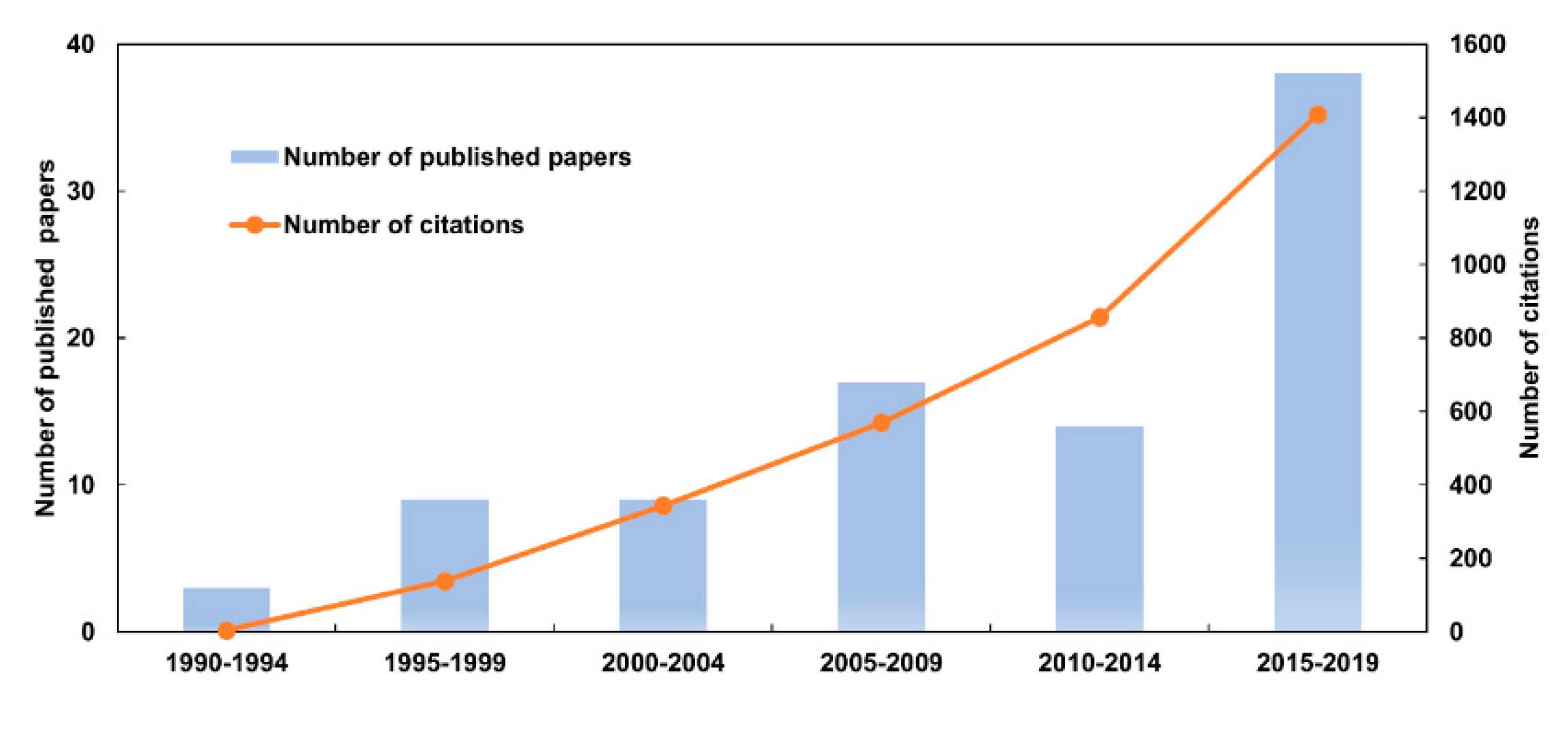

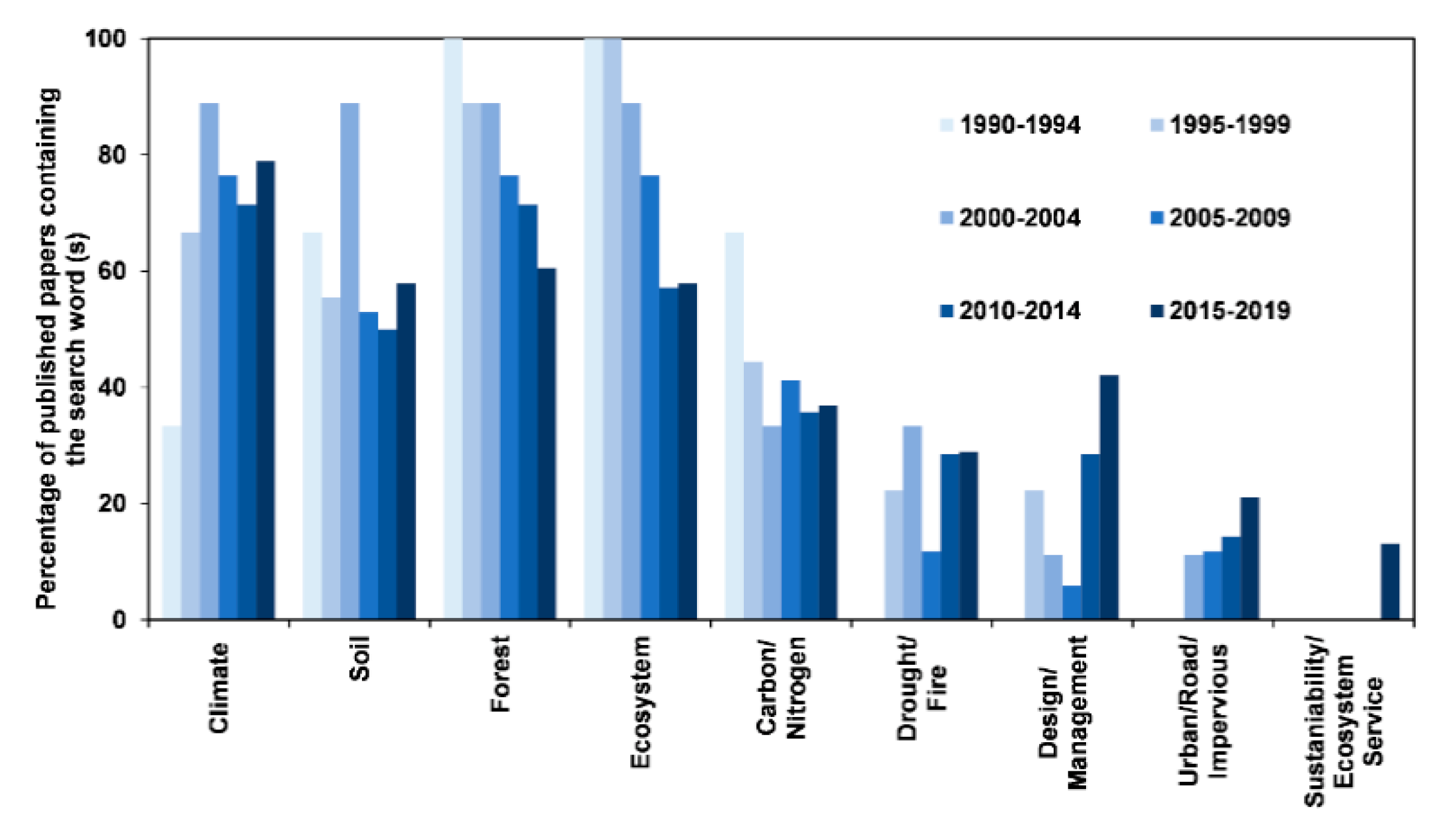
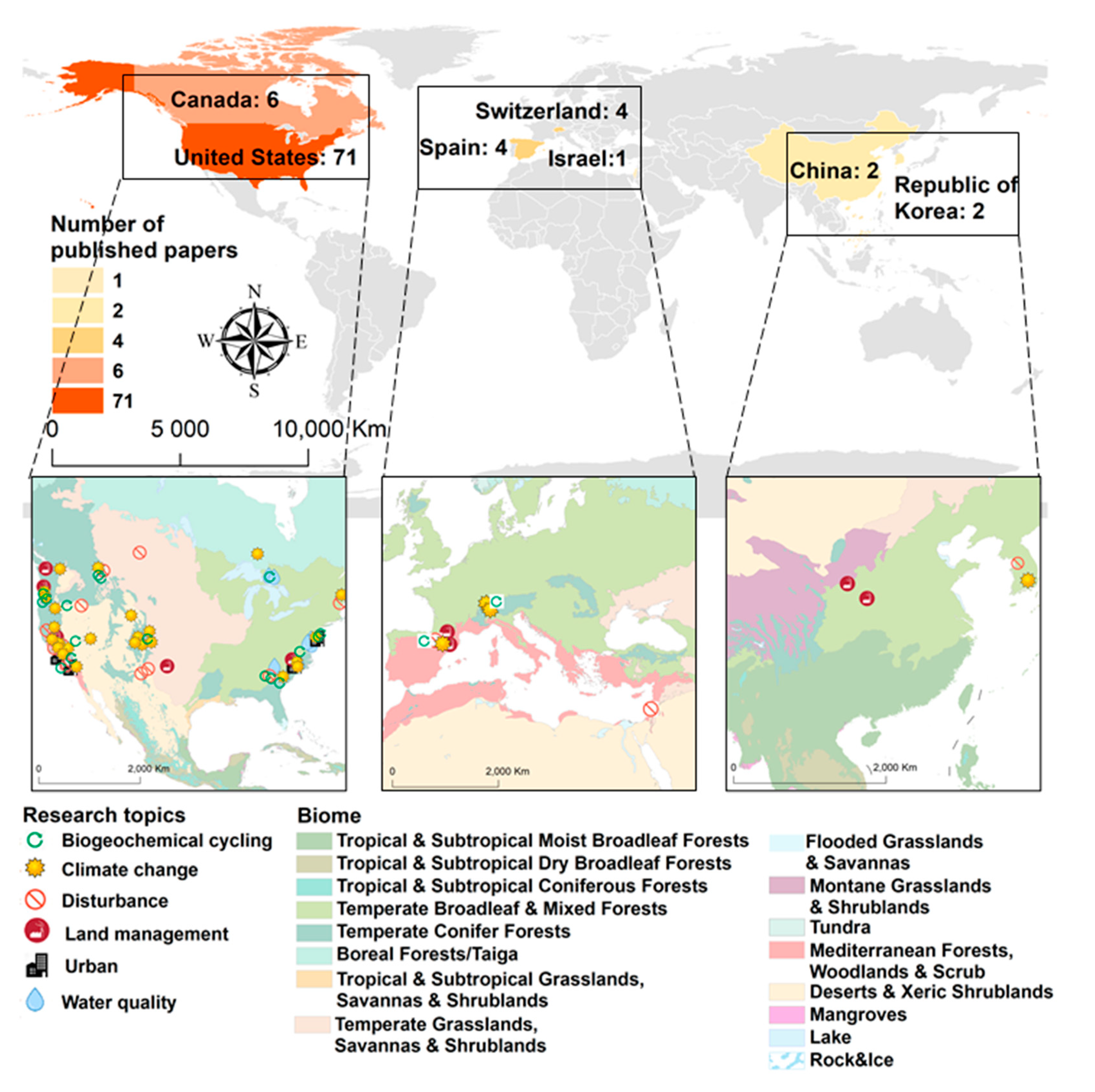
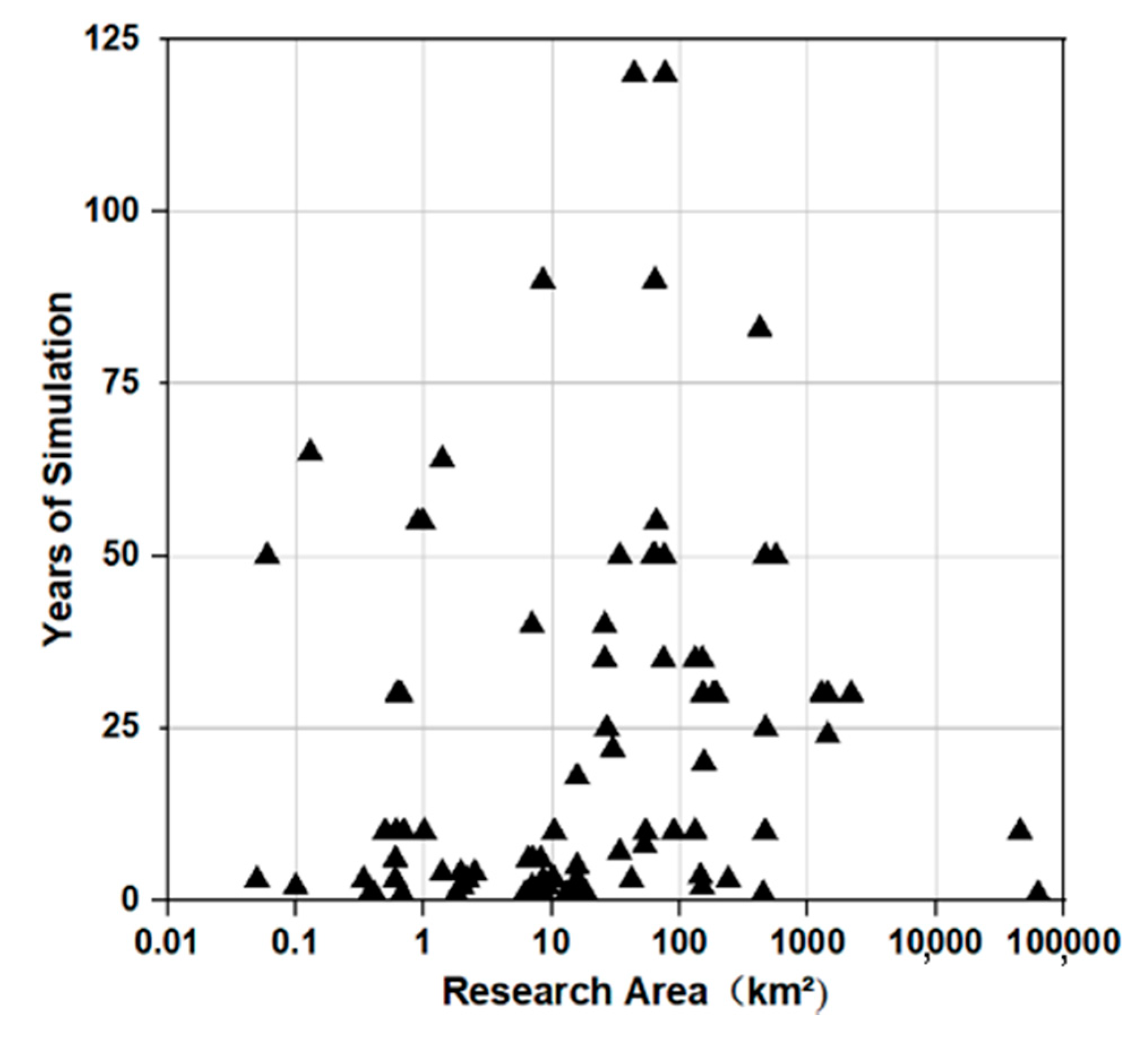
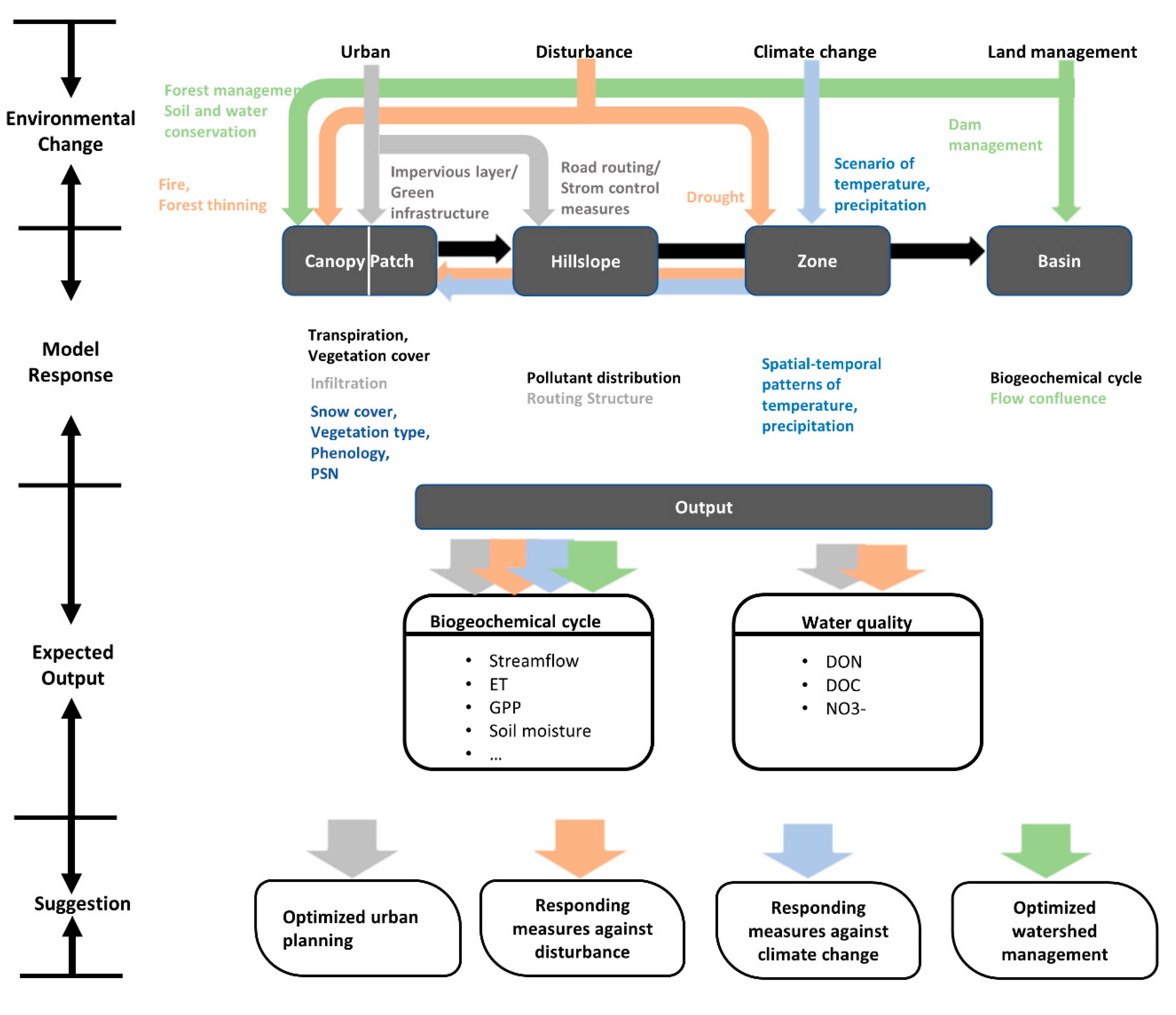
| Model | Structure | Key Processes Representing Eco-Hydrological Interactions | Applications | References |
|---|---|---|---|---|
| RHESSys | Basin-Zone-Hillslope-Patch-Canopy strata | Carbon and nitrogen cycling of soil and vegetation, Plant physiological process, Evapotranspiration, Lateral flow, Slope confluence | Urbanization, Water quality, Climate change, Disturbance, Water resource management, Land management, Biogeochemical cycle | [2] |
| TOPOG_IRM | Basin-subbasin | Carbon cycling of vegetation, Plant physiological process, Evapotranspiration, Lateral flow, Slope confluence | Climate change, Disturbance, Water resource management, Land management, Biogeochemical cycle | [19] |
| SWAT (Soil and Water Assessment Tool) | Basin-subbasin-Hydrological response units | Evapotranspiration, Lateral flow | Urbanization, Water quality, Climate change, Water resource management, Land management | [20] |
| BEPS-TerrainLab (Boreal Ecosystem Productivity Simulator-TerrainLab) | Basin-grid | Carbon and nitrogen cycling of soil and vegetation, Plant physiological process, Evapotranspiration, Lateral flow, Slope confluence | Water resource management, Biogeochemical cycle | [21] |
| tRIBS-VEGGIE (TIN-based Real-time Integrated Basin Simulator-Vegetation Generator for Interactive Evolution) | Basin-tin | Carbon cycling of soil and vegetation, Plant physiological process, Evapotranspiration, Lateral flow Slope confluence | Disturbance, Water resource management, Biogeochemical cycle | [22] |
| Category | Parameters | Description | Observed Data | Criteria * | Methods | References |
|---|---|---|---|---|---|---|
| Soil | m | The decay rate of saturated hydraulic conductivity with soil depth | Streamflow | NSe, LogNSe, RMSE, PBIAS, RSR | Monte Carlo, GLUE | [9,33,37,55,59] |
| Ksat0 | The saturated hydraulic conductivity at the soil surface (both dimension) | |||||
| gw1 | Groundwater bypass flow, dimensionless | |||||
| gw2 | Groundwater drainage rate, dimensionless | |||||
| psi | Soil pore-size index, dimensionless | |||||
| psi_air_entry | Soil air-entry pressure, dimensionless | |||||
| soil depth | Maximum soil dept, dimensionless | |||||
| Snow | Lapse_rate | The lapse rates for the daily maximum and minimum air temperature | Snow depth, SWE, Streamflow | R2 | Manually adjusted | [31,37,55] |
| max_snow_tem | Temperature threshold values for the partition of snow and rain in the total precipitation | |||||
| temcf | An empirical temperature melt coefficient (accounting for snowmelt due to latent and sensible heat) | |||||
| Vegetation | phenology date | Number of days for leaf out period and number of days for litterfall period | LAI | RMSE, Literature-based value | Manually adjusted | [18,38,54] |
| Q10 | Maintenance respiration (The proportional change in respiration per 10C rise in temperature) | |||||
| epc.flnr | Ration Leaf nitrogen in Rubisco to leaf nitrogen | |||||
| epc.proj_sla | Specific leaf area | |||||
| Water quality | kg | Base growth rate of chl-a in algae | DON, DOC fluxes | Kolmogorov-Smirnov D test | Monte Carlo, GLUE, Latin hypercube sampling (LHS) | [44,56] |
| kd | Base death rate of chl-a in algae | |||||
| kr | Base respiration rate of chl-a in algae | |||||
| vs | Settling rate of algae as chl-a | |||||
| ksn | Half saturation concentration of nitrogen | |||||
| ksp | Half saturation concentration of Phosphorous | |||||
| P | Phosphorous concentration in the SCM | |||||
| kpn | Constant of preferential NH4 uptake, over NO3 | |||||
| qg | Constant for kg dependency on temperature | |||||
| qd | Constant for kd dependency on temperature | |||||
| qr | Constant for kr dependency on temperature | |||||
| Is | Optimum radiation level for algae growth |
| Category | Observed Data | Source | Time Resolution | Criteria * | Methods ** | References |
|---|---|---|---|---|---|---|
| Streamflow | Streamflow | Gauge measurement | Daily, Monthly, Annual | NSe, LogNSe, PBIAS, R2 | Statistical analysis | [61] |
| Gauge measurement | Daily | Peak flow error, NSe, Flow variability, R2 | Statistical analysis | [63] | ||
| Gauge measurement | Daily, Monthly, Annual | NSe, PBIAS | MLE | [64] | ||
| Soil | Soil moisture | Field measurement | Daily | R | Correlation analysis | [65] |
| Snow | Snowmelt | Field measurement | Daily | R2 | Correlation analysis | [37] |
| Snow depth | Field measurement | Daily | R2 | Correlation analysis | [54] | |
| Vegetation | ET | Flux tower measurement | Daily | R2 | Correlation analysis | [59] |
| Flux tower measurement | Daily | RMSE, PBIAS, R2 | Correlation analysis | [5] | ||
| GPP | Remote sensing | Monthly | R2 | Correlation analysis | [59] | |
| Flux tower measurement | Daily | RMSE, PBIAS, R2 | Correlation analysis | [5] | ||
| NPP | Field measurement | Daily | N/A | Qualitative | [64] | |
| Field measurement | Annual | N/A | Qualitative | [67] | ||
| Remote sensing | Annual | Mean error | Statistical analysis | [9] | ||
| PSNet | Remote sensing | Daily | R2 | Correlation analysis | [59] | |
| Transpiration | Field measurement | Daily | R | Correlation analysis | [64] | |
| LAI | Field measurement | Daily | N/A | Qualitative | [68] | |
| Remote sensing | Daily | N/A | Qualitative | [9] | ||
| Water quality | DOC | Gauge measurement | Daily, Monthly, Annual | NSe, LogNSe | WRTD | [48] |
| NO3 | Monthly | NSe, R | Statistical analysis | [44] |
| Source | Specific Sources | Solutions | References |
|---|---|---|---|
| Input Data | Coarse-resolution of DEM | Fine-resolution DEM data | [55] |
| Lack of detailed precipitation, gauge, soil, and other basic data | Multi-source data acquisition | [6,34,37,71] | |
| Lack of carbon fluxes and pool data | Spin-up strategy, and integrate remote sensing data | [34] | |
| Model structure and algorithms | Interpolation strategy of air temperature and precipitation | Explicitly incorporate spatial characteristics of surface metrological variables | [7,37,54,71,72,73] |
| Without the plant migration and structure change | Couple vegetation dynamic models | [66] | |
| Without the in-stream process | SCM sub-model | [2,56] | |
| Scale problem | In-stream routing, and adapted landscape partitioning strategy | [9] | |
| Parameters | Simplification of vegetation variability | Multi-source data assimilation | [66,74] |
| Empirical parameters | Detailed filed studies, Calibration | [54,66,71,75] |
Publisher’s Note: MDPI stays neutral with regard to jurisdictional claims in published maps and institutional affiliations. |
© 2020 by the authors. Licensee MDPI, Basel, Switzerland. This article is an open access article distributed under the terms and conditions of the Creative Commons Attribution (CC BY) license (http://creativecommons.org/licenses/by/4.0/).
Share and Cite
Chen, B.; Liu, Z.; He, C.; Peng, H.; Xia, P.; Nie, Y. The Regional Hydro-Ecological Simulation System for 30 Years: A Systematic Review. Water 2020, 12, 2878. https://doi.org/10.3390/w12102878
Chen B, Liu Z, He C, Peng H, Xia P, Nie Y. The Regional Hydro-Ecological Simulation System for 30 Years: A Systematic Review. Water. 2020; 12(10):2878. https://doi.org/10.3390/w12102878
Chicago/Turabian StyleChen, Benxin, Zhifeng Liu, Chunyang He, Hui Peng, Pei Xia, and Yu Nie. 2020. "The Regional Hydro-Ecological Simulation System for 30 Years: A Systematic Review" Water 12, no. 10: 2878. https://doi.org/10.3390/w12102878
APA StyleChen, B., Liu, Z., He, C., Peng, H., Xia, P., & Nie, Y. (2020). The Regional Hydro-Ecological Simulation System for 30 Years: A Systematic Review. Water, 12(10), 2878. https://doi.org/10.3390/w12102878







